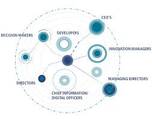Upgrade & Secure Your Future with DevOps, SRE, DevSecOps, MLOps!
We spend hours on Instagram and YouTube and waste money on coffee and fast food, but won’t spend 30 minutes a day learning skills to boost our careers.
Master in DevOps, SRE, DevSecOps & MLOps!
Learn from Guru Rajesh Kumar and double your salary in just one year.
Source:-devops.com
Developers are an integral part of digital transformation. They architect the modular systems that overcome legacy and build the applications and solutions that allow firms to deliver products and services in new and innovative ways. Yet, when it comes to business decisions, many organizations overlook their developer talent.
Developers come from a variety of different backgrounds, but it’s safe to say that most have studied computer science, engineering or mathematics in some form. Coming from these disciplines means they are inherent problem solvers, so giving them a seat at the table when it comes to discussing business goals is, of course, beneficial.
To ensure the business insights of developers can be unlocked, organizations should consider the following four points.
Encourage Personal Development
More and more developers are actively taking an interest in improving their communication and leadership skills, recognizing that these are important tools for career development.
Soft skills, for example, are key to establishing relationships internally, as well as communicating to external parties. At any moment, stakeholders may want to understand the workings of product teams, or it may be the case that a customer requires more attention when implementing a solution. In the former scenario, developers must become advocates for the business and the way they work; in the latter case they must ensure that they take an empathetic approach to end users.
Whether it’s learning new programming languages, getting to grips with new technologies, or developing soft skills, developers relish the chance to grow. Organizations that offer learning and development programs internally will likely attract developers who are both apt and keen to involve themselves in other areas of the business.
Keep Things Agile
Operating within an Agile framework gives developers and other members of product teams a chance to develop soft skills through scrum meetings. During a scrum meeting, each member of the team is given the opportunity to communicate openly about their challenges and devise solutions for other issues. This not only ensures a high level of transparency internally, it also allows business analysts to provide an accurate picture of progress to clients.
Sharing insights and troubleshooting in an open forum enables those with a natural inclination for leadership to establish themselves as effective communicators. The limited size of Agile teams also keeps things personal enough that each team member’s feedback can be heard and considered by their colleagues.
Agile software development brings disciplines together, encouraging an exchange of ideas and an expansion of knowledge. This is in stark contrast to the Waterfall method, where siloed teams hand off work with little communication.
With Agile, teams share responsibility, communicate and apply their disciplines in contexts outside those they are used to. In essence, Agile is the ideal way to establish a culture that enables learning and development on the job. This is much more practical than setting up a program that teaches soft skills and educates teams about other areas of the business, as these sessions can eat into work time and reduce productivity.
Be Clear on Requirements
It’s all well and good attracting the best and brightest developer talent, but in order to get the best from them, firms must be transparent about what is expected day to day.
Firstly, efficient code delivered in a timely manner should be the goal of every developer. Testing and QA will, of course, reveal issues, and no one is perfect, but developers must be mindful of the impact inefficient or inaccurate code can have on a business. Workarounds may get you past a problem, but this is not best practice and leaves the business exposed should a client pick up on it–especially if the workaround causes more serious issues further down the line.
Fewer bugs or defects means scrum meetings can naturally focus more on strategy and new initiatives that might help grow the business. Organizations should therefore establish best practices and coding guidelines to reduce the temptation for workarounds, ensuring code releases are reliable and ready for the production environment.
Developers must also be able to comprehend the requirement to work with designs given to them by design teams, as these will align with customer expectations. Being able to dynamically incorporate client feedback into the development process is also key, particularly for those working with continuous delivery and continuous integration pipelines.
An interest in emerging technologies is desirable, as is an eagerness to innovate new solutions using them, but so too is an aptitude to leverage rather than re-invent solutions. This helps to keep costs down and ensures a maximum return on investment in existing solutions.
Keep an Eye on the Future
Increasingly, the ease with which organizations can react to advances in technology will determine their long-term success. It is therefore in their interest to ensure developers have the freedom to learn new skills and explore new tools that might increase efficiency or unlock new offerings.
Advances in IoT, connected devices, augmented and virtual reality, AI and machine learning, blockchain and 5G networks are just some of the technologies opening up new challenges for firms and developers alike.
Developers with the skills to harness these technologies will increase their employability, allowing them to secure better positions and salaries. They will also be well placed to advise on wider business goals, positing new use cases and solutions and fueling innovation.

 Starting: 1st of Every Month
Starting: 1st of Every Month  +91 8409492687 |
+91 8409492687 |  Contact@DevOpsSchool.com
Contact@DevOpsSchool.com